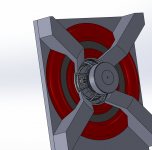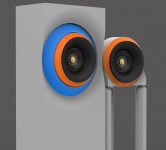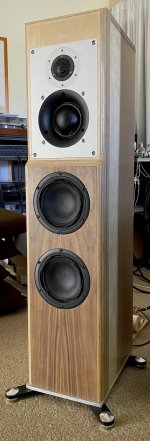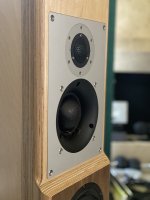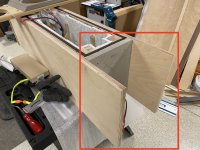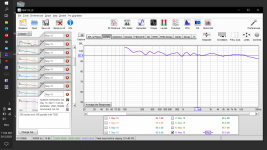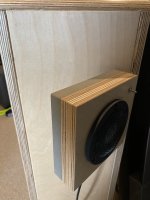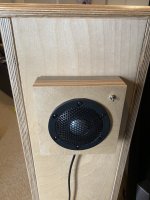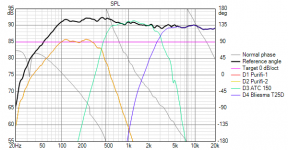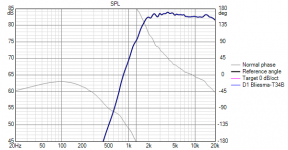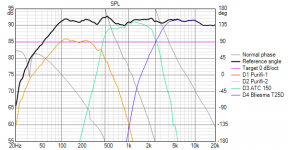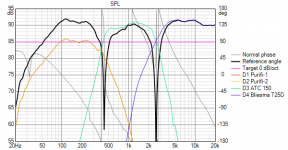Here's the idea I was playing around with. The driver is actually suspended via a basket to the baffle, similar to how the speaker's own basket looks. I left that out for a simpler view of what I want to do. There are probably a number of reasons against such a configuration, but there also appear, at least on the surface, to be solutions for most issues I'm aware of. Admittedly there is more that I am unaware of than aware of. The driver can be internally baffled if that is required. Spider suspension can be employed if that matters, and so on. The surrounds could be flipped upright and because I'm considering polyethyl, it should be diffraction friendly. The mass is highly controllable, anywhere from very light to what ever mass is preferred. Then again, I've not seen this done so maybe there is some unwritten rule about why....
Very cool idea - super creative. The mass though, if I understand this right, is the mass of the PTT6.5? Which is kind of high for a passive radiator as the frame and magnets really add up. The fs needs to be around 30Hz and you may have a hard time getting that to match up with the 8 lb driver "radiator mass".
The other possible issue might be Doppler modulation/distortion will be worse now that the woofer literally moves a large distance as the higher frequency tones are played simultaneosly while the driver is moving back and forth over a longer distance.
@Norman Tracy, thanks, I had a lot of fun on that render! I'm just now getting into dust and smudges for that extra touch. Every time I learn to do that stuff I find 've completely forgotten it for the next go around. Also, thanks for the tip on the Crowe build. I had been following but wasn't aware the floor-stander was right on that 20L mark, so good to see that data.
@xrk971, thanks for chiming in! It's confusing the way I left out the rear brace for visual simplification because it looks like the PTT is free floating. It's actually rigidly mounted like usual. I did a crude model just to show that the driver is fixed at the baffle. What I'm thinking now is to put the PTT in a waveguide to give it some distance from the PR. This will also allow the PR to be moved axially to an optimal distance from the PTT for timing. Finally, the logical extreme would be to have a large concentric subwoofer which is an inspiration taken from Onslo's build as seen on #764. The actual mass of the PR as shown in earlier renditions comes out to about 60g, IIRC. So basically less then half that of a dual Purifi PR configuration. I realize that may be too light, but it just gives plenty of room to add mass via whatever means desired. The concept is evolving into a "Driver Module" or "Driver Cluster" theme. A quick mockup shows a single module with PR on a stand, next to the same module fitted with a concept 15" equivalent subwoofer driver. In this example, the PTT is even hacked with cone mods to fit coaxial tweeter.
All fun and games until someone looses a Purifi 😀
@xrk971, thanks for chiming in! It's confusing the way I left out the rear brace for visual simplification because it looks like the PTT is free floating. It's actually rigidly mounted like usual. I did a crude model just to show that the driver is fixed at the baffle. What I'm thinking now is to put the PTT in a waveguide to give it some distance from the PR. This will also allow the PR to be moved axially to an optimal distance from the PTT for timing. Finally, the logical extreme would be to have a large concentric subwoofer which is an inspiration taken from Onslo's build as seen on #764. The actual mass of the PR as shown in earlier renditions comes out to about 60g, IIRC. So basically less then half that of a dual Purifi PR configuration. I realize that may be too light, but it just gives plenty of room to add mass via whatever means desired. The concept is evolving into a "Driver Module" or "Driver Cluster" theme. A quick mockup shows a single module with PR on a stand, next to the same module fitted with a concept 15" equivalent subwoofer driver. In this example, the PTT is even hacked with cone mods to fit coaxial tweeter.
All fun and games until someone looses a Purifi 😀
Attachments
Purifi 6.5 in Sealed Box
I recently finished a pair of 3-way speakers using two Purifi 6.5" (PTT6.5X08-NFA-01) drivers per side. It ended up being my most complex woodworking project, taking me a couple of months of planning and work.
I used 12L/driver as rec'd by Purifi. The volume worked out well using a Parts-Express Denovo Knock-down cabinet. This cabinet was used for the prototype as well as the "inside" of the final speaker cabinet (excluding the prototype's front baffle).
Besides the two Purifi drivers, an ATC-75-150 serves as the MR and a Bliesma 34mm Beryllium (T34B) is the tweeter. Later, as described below, the 34mm was used on the rear and a Bliesma T25D was used in an adapter plate on the front.
The reason the construction became complicated for me is I decided to use CLD between the inner ¾" MDF cabinet and an outer layer using ¾” AppyPly plywood. The CLD was 1/16” thick 3M HVB tape. So all sides, top, bottom (the bottom is 3/4" MDF and 3/4" HDF), and back are therefore ~1.5" thick.
The front baffle was made of a ¾" ApplePly "sub-baffle" + a 1" ApplePly baffle followed by another ¾" ApplePly layer (in Walnut) as an "epi-baffle" for the Purifi drivers. This is more easily seen in the attached photos. Thus, the top of the baffle is 1.75” thick while the bottom is 2.5” thick.
I ended up doing a lot of router work to get the edges aligned and rounded over the front edges with a ¾" bit. There is a ¾" chamfer on top edge of the Purifi baffle.
To allow for potential modifications (a Bliesma 3" dome is due at the end of this year; the T25D could then be moved closer to the MR), a removable aluminum plate was used to house the tweeter and midrange drivers (mainly because the ATC is rear mounted due to its insanely large magnet). This plate is 10mm thick and was CNC machined by FrontPanelExpress.
The height of the speaker was increased by 6" over that of the prototype by creating a cavity at the base to get the height of the MR/tweeter to ear level along with creating an external volume in which to place the crossover (highlighted in red below). The base was made using a 10mm thick aluminum panel also CNC'd by FrontPanelExpress. The out-rigger parts were sourced from Amazon. The final speaker height is 43" with out-riggers. The cabinet width is 9.5" and depth is 13.5" at the base.
The crossover uses mostly Jantzen parts, including Alumen caps. X/O points are 400 Hz and 3kHz, all 4th order. The resulting FR is reasonable with a purposeful downward HF attenuation. The THD seems rather good at ~0.3% at 100dB. The calculated low frequency range is ~58Hz but in room response seems fairly flat to the 30s. Besides tight bass, another reason for choosing a sealed box is to better integrate with subwoofers, which I use for home theater listening (no subs are used when streaming hi res music). Each speaker is presently driven by a March Audio P451 monoblock, Purify-based amplifier, which are driven by my own designed tube preamplifier based on 5670 tubes.
After changing the T34B for the T25D, I re-purposed the T34B as a rear tweeter. But instead of installing in the rear panel, I wanted more flexibility in aligning the rear (out-of-phase) projection. Using scrap 1" ApplePly and ¾" HDF, I made a small box for the rear with mirror-image hinges (and an on/off switch). The X/O for this is a 2nd order at ~1.2kHz (cabling will later be internalized).
I recently finished a pair of 3-way speakers using two Purifi 6.5" (PTT6.5X08-NFA-01) drivers per side. It ended up being my most complex woodworking project, taking me a couple of months of planning and work.
I used 12L/driver as rec'd by Purifi. The volume worked out well using a Parts-Express Denovo Knock-down cabinet. This cabinet was used for the prototype as well as the "inside" of the final speaker cabinet (excluding the prototype's front baffle).
Besides the two Purifi drivers, an ATC-75-150 serves as the MR and a Bliesma 34mm Beryllium (T34B) is the tweeter. Later, as described below, the 34mm was used on the rear and a Bliesma T25D was used in an adapter plate on the front.
The reason the construction became complicated for me is I decided to use CLD between the inner ¾" MDF cabinet and an outer layer using ¾” AppyPly plywood. The CLD was 1/16” thick 3M HVB tape. So all sides, top, bottom (the bottom is 3/4" MDF and 3/4" HDF), and back are therefore ~1.5" thick.
The front baffle was made of a ¾" ApplePly "sub-baffle" + a 1" ApplePly baffle followed by another ¾" ApplePly layer (in Walnut) as an "epi-baffle" for the Purifi drivers. This is more easily seen in the attached photos. Thus, the top of the baffle is 1.75” thick while the bottom is 2.5” thick.
I ended up doing a lot of router work to get the edges aligned and rounded over the front edges with a ¾" bit. There is a ¾" chamfer on top edge of the Purifi baffle.
To allow for potential modifications (a Bliesma 3" dome is due at the end of this year; the T25D could then be moved closer to the MR), a removable aluminum plate was used to house the tweeter and midrange drivers (mainly because the ATC is rear mounted due to its insanely large magnet). This plate is 10mm thick and was CNC machined by FrontPanelExpress.
The height of the speaker was increased by 6" over that of the prototype by creating a cavity at the base to get the height of the MR/tweeter to ear level along with creating an external volume in which to place the crossover (highlighted in red below). The base was made using a 10mm thick aluminum panel also CNC'd by FrontPanelExpress. The out-rigger parts were sourced from Amazon. The final speaker height is 43" with out-riggers. The cabinet width is 9.5" and depth is 13.5" at the base.
The crossover uses mostly Jantzen parts, including Alumen caps. X/O points are 400 Hz and 3kHz, all 4th order. The resulting FR is reasonable with a purposeful downward HF attenuation. The THD seems rather good at ~0.3% at 100dB. The calculated low frequency range is ~58Hz but in room response seems fairly flat to the 30s. Besides tight bass, another reason for choosing a sealed box is to better integrate with subwoofers, which I use for home theater listening (no subs are used when streaming hi res music). Each speaker is presently driven by a March Audio P451 monoblock, Purify-based amplifier, which are driven by my own designed tube preamplifier based on 5670 tubes.
After changing the T34B for the T25D, I re-purposed the T34B as a rear tweeter. But instead of installing in the rear panel, I wanted more flexibility in aligning the rear (out-of-phase) projection. Using scrap 1" ApplePly and ¾" HDF, I made a small box for the rear with mirror-image hinges (and an on/off switch). The X/O for this is a 2nd order at ~1.2kHz (cabling will later be internalized).
Attachments
Last edited:
Badass! Any first impressions on how it sounds? The T34B is on my wish list. Why did you configure them on the rear?
They sound really good. They're much more dynamic and can play louder with less distortion than my electrostatics (a pair of rather rare Nakamichi Dragons). In comparison, the electrostatics begin to distort at high levels. At the same time, the 3-way seem to have less harshness and less trouble with sibilants than other speakers that I've heard (even less than the Nakamichis).
As for the rear T34Bs, they're to give an optional dipole radiation pattern. The 34mm goes a bit lower than a 25mm and has very low distortion. I run them slightly attenuated from the front drivers (and, as mentioned, in reverse phase).
Since I keep the speakers toed-in, the usual dipole tweeter arrangement on the rear panel would force the tweeters to radiate more towards the side walls. By placing the T34Bs on a hinge, when angled more towards the center of the rear wall, they enlarge the sweet spot, making a wide, cohesive sound. I find it better for home theater application, esp dialog, as I don't use a center channel. For music listening, I typically leave them turned off.
As for the rear T34Bs, they're to give an optional dipole radiation pattern. The 34mm goes a bit lower than a 25mm and has very low distortion. I run them slightly attenuated from the front drivers (and, as mentioned, in reverse phase).
Since I keep the speakers toed-in, the usual dipole tweeter arrangement on the rear panel would force the tweeters to radiate more towards the side walls. By placing the T34Bs on a hinge, when angled more towards the center of the rear wall, they enlarge the sweet spot, making a wide, cohesive sound. I find it better for home theater application, esp dialog, as I don't use a center channel. For music listening, I typically leave them turned off.
Last edited:
Robert,
Clever, “go for SOTA” engineering!
How did you decide those crossover points … are you happy with them?
Clever, “go for SOTA” engineering!
How did you decide those crossover points … are you happy with them?
Last edited:
I recently started using VituixCAD to extract the FRD and ZMA data
…
…
I also added an XSim file for a crossover
Hi (I think it’s) Robert
Does the above mean that VituixCAD is better for extracting that data, but you prefer XSim to design crossovers?
Cheers
Last edited:
otto88,
VituixCAD is decidedly better. I ended up using it exclusively, along with REW and Dayton Audio's DATS V3. VituixCAD was also accurate for the box dimensions, agreeing with the 12L/driver rec'd by Purifi.
The simulations were essentially spot with only minor L-pad adjustments (the adjustments were a bit different from the VituixCAD estimations). One thing I'd not noticed before was how the specific L-pad ratio and values, using discrete resistors, affect the tilt of the tweeter. Such tweaking allowed very fine alterations of the overall balance. Of course, such changes required many REW measurement and soldering iterations.
Attached is one of the final VituixCAD estimates which agrees rather well with the REW measurement I posted above, using the same value components in the X/O as in the simulation.
As an aside, the Bliesma T34B is one of the easiest to use tweeters I've ever measured. It literally is plug-n-play between VituixCAD and REW with an extremely flat response. Shown below is the X/O and response for the rear mounted T34B. I gave it a slight downward tilt too, adjusted by the two resistors.
VituixCAD is decidedly better. I ended up using it exclusively, along with REW and Dayton Audio's DATS V3. VituixCAD was also accurate for the box dimensions, agreeing with the 12L/driver rec'd by Purifi.
The simulations were essentially spot with only minor L-pad adjustments (the adjustments were a bit different from the VituixCAD estimations). One thing I'd not noticed before was how the specific L-pad ratio and values, using discrete resistors, affect the tilt of the tweeter. Such tweaking allowed very fine alterations of the overall balance. Of course, such changes required many REW measurement and soldering iterations.
Attached is one of the final VituixCAD estimates which agrees rather well with the REW measurement I posted above, using the same value components in the X/O as in the simulation.
As an aside, the Bliesma T34B is one of the easiest to use tweeters I've ever measured. It literally is plug-n-play between VituixCAD and REW with an extremely flat response. Shown below is the X/O and response for the rear mounted T34B. I gave it a slight downward tilt too, adjusted by the two resistors.
Attachments
Last edited:
This is very nice driver combo and dual purifi is what I would choose too for small slim 3way lodspeaker. In your previous post you mentioned 4th order between mid and tweeter. From individual response graph the drivers summation at the crossover is 3dB. Whais phase alignment of the drivers?
Thanks. The drivers are in phase for proper summation.
I didn't go by any fixed theoretical ratio of inductor-capacitor was gradually varied each to get the desired roll-off, tilt and summation.
I didn't go by any fixed theoretical ratio of inductor-capacitor was gradually varied each to get the desired roll-off, tilt and summation.
Last edited:
As summation is 3dB only, not full 6dB which is normal for lr4 alignment, there is ~90deg difference between acoustic phases of mid and tweeter.
So could you say the short story is an 15 L with an PR 5"x8" could work in normal volume?
Hello Solve,
Yes 15 L with one or two Purifi PTT6.5PR or SB Acoustics SB15SFCR-00 PRs is a very optimal very high performance very enjoyable solution for the PTT6.5W.
happy building and listening
Last edited:
I agree. The PTT6.5 has lower distortion than any other driver I have measured in this range. Those numbers are all real - it can be used as a low distortion midrange up to 5.5kHz.
I have been working on a new floorstanding TL for the Purifi (top driver) with tweeter in a waveguide (lower driver):
Any update, i was demoing a gryphon mojo s and I really love albeit from the price. Doing with some research, I found that the driver unit is a seas customized long stroke unit. So I think mtm purifi ppt6.5 so the closest unit we can make a super clone mojo s.
Hello Solve,
Yes 15 L with one or two Purifi PTT6.5PR or SB Acoustics SB15SFCR-00 PRs is a very optimal very high performance very enjoyable solution for the PTT6.5W.
happy building and listening
Has anyone had an opportunity to compare the PTT6.5PR and the SB15SFCR-00 for use with the PTT6.5W? The SB sure saves a lot of cash.
As summation is 3dB only, not full 6dB which is normal for lr4 alignment, there is ~90deg difference between acoustic phases of mid and tweeter.
You are correct, thanks for pointing this out (I had it correct when the T34B was on the front; the T25D takes more work).
I made a few small changes in X/O values for the MR and tweeter to get the following responses in VituixCAD shown below (which I'll adjust on the speakers tonight). Now there is a 6dB LR4 summation with expected null as shown when the MR has its phase inverted.
Attachments
Any update, i was demoing a gryphon mojo s and I really love albeit from the price. Doing with some research, I found that the driver unit is a seas customized long stroke unit. So I think mtm purifi ppt6.5 so the closest unit we can make a super clone mojo s.
There may be someone out there in the wild building this. I have been too busy with other stuff to make this floor standing TL.
No passive radiator on a speaker's rear panel does not act anything like a bipolar speaker does. The passive radiator has only a very limited frequency range of output limited to the bass where sound radiates omnidirectionally.
Perhaps off topic (or old news), but I note that Purifi is previewing a 6.5" midrange.
PTT6.5M04-NFA-01
The FR and distortion looks great until 3k or so. I will have to wait to see the off-axis response, but I wish they had come out with a PTT4.0M so beaming wasn't an issue. Perhaps they thought it more important to boost the efficiency.
Thanks for the news. Lets wait for the off axis but I curious what would be the advantage of this dedicated midrange if power is not a problem (active 3 way for instance).
- Home
- Loudspeakers
- Multi-Way
- Exploring Purifi Woofer Speaker Builds
